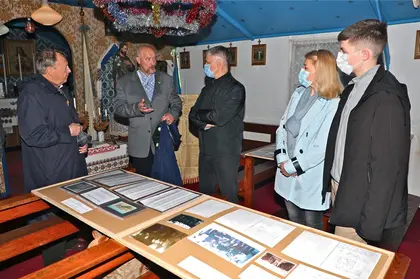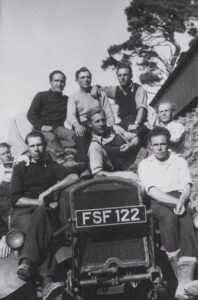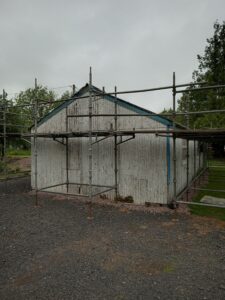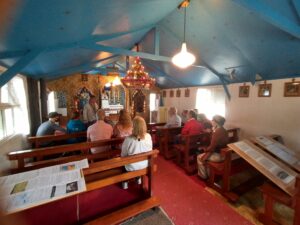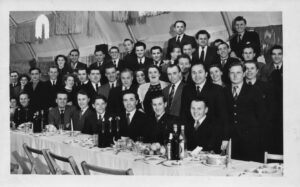With Putin’s war on Ukraine leading to the destruction of many churches and places of worship, the new, recently-settled wave of Ukrainian refugees arriving in Scotland, are now helping to bring to life a Second World War chapel in Lockerbie, which was housed in a camp that held 463 Ukrainian Prisoners of War (POWs).
Lockerbie is located in south-western Scotland, and is remembered for the downing of Pan Am Flight 103. A bomb exploded on board the plane on December 21, 1988 as it flew over the small town, killing 243 passengers, 16 crew and 11 people.
JOIN US ON TELEGRAM
Follow our coverage of the war on the @Kyivpost_official.
The Lockerbie Disaster Memorial is located in the area in memory of the victims of the deadliest terrorist attack in the history of the United Kingdom.
The same town has, over the years, become known for another important but lesser well-known part of its history, Camp 68, on Hallmuir Farm, on what is now left of a Ukrainian POW Chapel.
Back in 1942 it was a working camp built to house Italian and German POWs. Its main compound contained 24 huts, and it was surrounded by barbed wire fencing. The guard’s area alongside the road had 21 huts.
By June 1947, 463 Ukrainian POWs – members of the Galician Division – had arrived.
What is left today is a Chapel that these soldiers – both Ukrainian Catholic and Orthodox – would squeeze into to hold prayers. It can hold about 50 people. Most of the huts and barracks have long since disappeared, but the focus is now on preserving the Chapel structurally.
Mike Ostapko, a trustee and overseer of the Chapel, said “a fundraising campaign started in 2018 to raise £80,000 in order to save the Grade-B listed building, but during the recent pandemic the Chapel was closed, so no money was coming in.
“The South of Scotland Enterprise (SOSE) gave £55,000 so we now have £90,500. We’ve got the drainage done, the windows and a new door will be put in once the roof and guttering has been replaced. Hopefully, if the weather holds, it should be complete in the next two weeks. The building will be wind and water tight.
“The second phase is a barrack, which we want to turn into a reception, activity and community centre. It is bigger than the Chapel and will be used for displays of artefacts and other things relating to and those who lived in Lockerbie.
“The last phase will be the demolition of a large cross which stands beside the Chapel. We want to erect a Cossack cross, the type you see on graves in Lviv, where soldiers are buried. Our intention is to have that type in memory of the men that were at Lockerbie.”
For those who have not been to the Chapel or seen it since it was emptied – the contents include hand-painted religious pictures by POWs, armoured shells turned into candlesticks, a miniature model cathedral on the altar carved out with a penknife and two flags made out of Italian tents from Rimini. One reads in Ukrainian: “In memory to those who fell in battle.” Everything removed inside the Chapel will be put in the same place once repairs are complete.
Ostapko, 70, has a family with a long military history, so the Chapel holds a special place in his heart.
“My grandfather Ivan was a Hussar, a cavalryman in the Austro-Hungarian army. My father Michael was 16 and lied about his age to get into the Galician Division. He fought at Brody, where he was wounded.
“My father was also part of a group that set up the first Ukrainian building in Munich where they were working with Ukrainian nationalist leader Stepan Bandera.
“I joined the Royal Scots Greys, which later became The Royal Scots Dragoon Guards. I had a variety of roles. I was a tank commander, Army Air Observer on Helicopters, and was attached to the British Military Mission to the Soviet Union called BRIXIMIS to Berlin. Our duties were to go into the soviet zone and gather intelligence.”
With such a pedigree in military matters, his opinion on the West’s response to Putin’s invasion was not overly flattering. “I was bitterly disappointed that the rest of the world did nothing in 2014 when the Russians invaded Crimea. It has taken the Western Allies long enough to see what is going on.”
Two years into his job as chair of the Edinburgh branch of the Association of Ukrainians in Great Britain, they were already sending aid to soldiers fighting in the industrial Donbas region, their families, widows and orphans.
“We are still doing that and are now supporting the 7,000-8,000 and more Ukrainians coming to Scotland,” he said.
He stepped down as chair after spending six years in the post.
Returning to the subject of the Chapel, Ostapko said they no longer hold regular church services. The priest only comes for special occasions. With the latest influx of Ukrainians into the area, he hopes they can get regular church services going again.
“We have so many Ukrainians in the Dumfries and Galloway area, and quite a few of them are interested in the Chapel. Oddly enough, the Chapel has also become a hub for humanitarian aid. Those refugees that have been to the Chapel are helping us and want to take part.”
The Ukrainian men from the camp were allowed to leave in the early 1950s. Some stayed, but a lot went to live in the south of England, Canada, America, New Zealand, Australia and some returned to Europe.
The guestbook at the Chapel illustrates that people from all over the world visit. They are usually relatives of the men that were at the camp, and many are becoming acquainted with Ukraine’s history and culture due to the war. Lockerbie’s Ukrainian gem is here to stay.
As Professor Russel Griggs, chair of South of Scotland Enterprise, said: “The Chapel is an asset to the local Lockerbie community, and it is vital that we do everything we can to help preserve buildings such as this, which are steeped in history and serve a very important purpose to the people that use them.
“Our funding will help to ensure the safety and longevity of the building, so that it remains a key part of the local community for years to come.”
And the number of Ukrainians coming to Scotland is rising all the time. “Even though the majority of Ukrainian refugees are coming to Edinburgh,” said Ostapko, “the Scottish government is now moving people to more remote areas.”
According to local press reports (Scottish Housing News, May 23, 2022) 1,300 refugees have arrived in Edinburgh alone, though this figure has increased since then.
The capital Edinburgh has always been the focal point of Ukrainian diaspora life in Scotland.
The expectation on the shoulders of the newly-arrived diaspora is that they’ll write the next chapter in the history of Ukrainians in Scotland.
Friends of Ukrainian POW Chapel, Hallmuir, Lockerbie.
You can also highlight the text and press Ctrl + Enter


